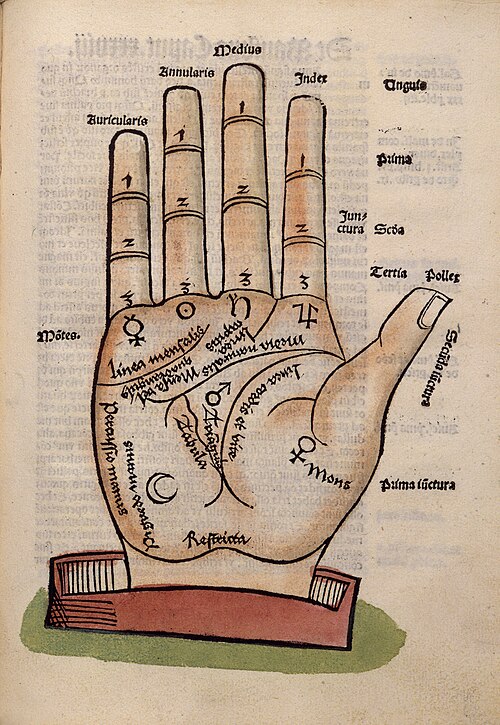Chiromancy
Palmistry, also known as palm reading, chiromancy, or chirology, is the practice of divination through the study of the palm. The practice is found all over the world, with numerous cultural variations. Those who practice chiromancy are generally called palmists, hand readers, hand analysts, or chirologists.
There are many interpretations of various lines and palmar features across various teachings of palmistry. Palmistry is practiced by the Hindu Brahmins, and is also indirectly referenced in the Book of Job. The contradictions between different interpretations, as well as the lack of evidence for palmistry's predictions, have caused palmistry to be viewed as a pseudoscience by academics.
Ancient palmistry
Palmistry is a practice common to many different places on the Eurasian landmass; it has been practiced in the cultures of India, Nepal, Tibet, China, Persia, Sumeria, Canaan and Babylonia.
The acupuncturist Yoshiaki Omura describes its roots in Hindu astrology (known in Sanskrit as jyotish), Chinese Yijing (I Ching), and Roma fortune tellers. Several thousand years ago, the Hindu sage Valmiki is thought to have written a book comprising 567 stanzas, the title of which translates in English as The Teachings of Valmiki Maharshi on Male Palmistry. From India, the art of palmistry spread to China, Tibet, Egypt, Persia and to other countries in Europe.
Palmistry also progressed independently in Greece where Anaxagoras practiced it. Aristotle (384–322 B.C.E.) reportedly discovered a treatise on the subject of palmistry on an altar of Hermes, which he then presented to Alexander the Great (356–323 B.C.E.), who took great interest in examining the character of his officers by analyzing the lines on their hands. A chapter of a 17th-century sex manual, misattributed to Aristotle, is occasionally incorrectly cited as being the treatise in question. The text it is not contained in his canonical works.
Palmistry is indirectly referenced in the Biblical Book of Job, which is dated by scholars to between the 7th and 4th centuries BCE.
Renaissance Europe
In Renaissance magic, palmistry (known as "chiromancy") was classified as one of the seven "forbidden arts", along with necromancy, geomancy, aeromancy, pyromancy, hydromancy, and spatulamancy (scapulimancy). During the 16th century the art of palmistry was actively suppressed by the Catholic Church. Both Pope Paul IV and Pope Sixtus V issued papal edicts against various forms of divination, including palmistry.
Modern palmistry
Palmistry experienced a revival in the modern era starting with Captain Casimir Stanislas D'Arpentigny's publication La Chirognomie in 1839. Today, it is often linked in with other esoteric practices as a New Age belief.
The Chirological Society of Great Britain was founded in London by Katharine St. Hill in 1889 with the stated aim to advance and systematise the art of palmistry and to prevent charlatans from abusing the art. Edgar de Valcourt-Vermont (Comte C. de Saint-Germain) founded the American Chirological Society in 1897.
A pivotal figure in the modern palmistry movement was the Irish William John Warner, known by his sobriquet, Cheiro. After studying under gurus in India, he set up a palmistry practice in London and enjoyed a wide following of famous clients from around the world, including famous celebrities like Mark Twain, W. T. Stead, Sarah Bernhardt, Mata Hari, Oscar Wilde, Grover Cleveland, Thomas Edison, the Prince of Wales, General Kitchener, William Ewart Gladstone, and Joseph Chamberlain. So popular was Cheiro as a "society palmist" that even those who were not believers in the occult had their hands read by him. The skeptical Mark Twain wrote in Cheiro's visitor's book that he had "exposed my character to me with humiliating accuracy."
Edward Heron-Allen, an English polymath, published various works including the 1883 book, Palmistry – A Manual of Cheirosophy, which is still in print. There were attempts at formulating some sort of scientific basis for the art, most notably in the 1900 publication The Laws of Scientific Hand Reading by William Gurney Benham.
In popular culture
In 1970, Parker Brothers published a game designed by Maxine Lucille Fiel called "Touch-Game of Palmistry" which allowed players have "palm reading and analysis" through selecting cards that matched designated palm features.
Palmistry features as a plot device in many films, especially horror movies, including:
- Carnival of Blood (1970)
- Spellbinder (1988)
- Clownhouse (1989)
- Jacob's Ladder (1990)
- The Lords of Salem (2012)
